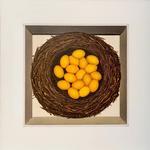Son of Heaven 9
Li Rui
李锐
Production date
2010
Object Detail
Media
oil on canvas
Measurements
100 x 100 cm
Notes
As a young student, Li Rui was fascinated by archaeology and natural history, and how archaeological objects and natural specimens are displayed in museums. Many of his paintings feature imagery of birds and their eggs, such as the ‘Son of Heaven’ and ‘Nest’ series in the White Rabbit Collection. The Son of Heaven in the title refers to the Chinese emperor, who was believed to rule by the Mandate of Heaven. The colour yellow was associated with the Emperor, who was often depicted wearing elaborate yellow robes. It is also associated with yin and yang in Daoist philosophy. Eggs and birds occupy a special, symbolic place in Chinese cosmology. According to a Chinese creation myth, in the beginning there was chaos. From this darkness emerged an egg, which represented the universe. The first being, called Pangu, slept inside the egg of the universe for aeons, growing bigger and bigger while the principles of yin and yang took shape. Eventually Pangu became so big that he broke through the shell of the egg and awoke. He used his axe to cleave apart the forces of yin and yang: all that was light became the sky (yang), and all that was heavy formed the earth (yin). For Li Rui, the eggs symbolise both birth and death, and therefore are connected with the fluxing reciprocal relationships between yin and yang. By placing his painted nest within a shallow box, Li is also suggesting the intervention of human artifice in the natural world.
Accession number
2014.078

